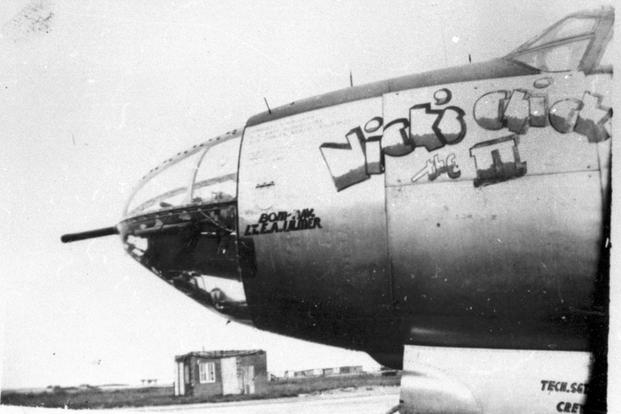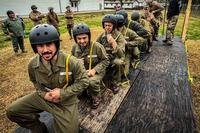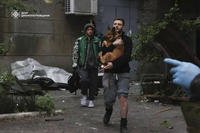I was a bombardier on the B-26 Nick's Chick in the 344th bomb group, 495th squadron. The following are the recollections that I have of D-Day and taken from memory and some notes that I kept.
D-Day was my 22nd mission. We were confined to the post for a week ahead, but I didn't think too much of it because it had happened before. But the night of the 5th, we realized from some things that were happening, such as the planes down on the flight line being painted with large black and white stripes, that this was probably going to be it.
All the crews in our squadron got up about 12:30, and we ate breakfast about 0100. At 0200 we went to briefing. When we got into briefing, the colonel told us that this was the invasion and we were to knock out three coastal guns on the east side of Cherbourg.
As we understood then, the Americans were landed at Cherbourg and the British on up the beach at Caen. We took off in the dark. We flew No. 2 position in the second flight. We carried a D-8 bomb sight. The D-8 was a simple instrument when compared to the Norden bomb sight, but was accurate at low levels.
This was to have been my first lead mission if we bombed below 4,000 feet. They told us we were to bomb, no matter what. As the weather was bad, if we bombed under 4,000 feet, I was to lead and bomb with the D-8 sight, and if we bombed above 4,000 feet, the lead ship was going to use the Norden.
As it turned out, we could see well enough, and he did use the Norden sight.
When we went across the Channel, the number of ships that we saw were just, well, there's just no way to describe them. As far as you could see, there were ships.
As we got closer to the coast, we could see large warships of some kind shelling the French coast, and there were so many of them doing it, it looked like there were fireflies in a big field, just a constant sparkle down there as the big guns went off.
We were to bomb the coastal battery at 20 minutes before the troops hit so we went across right at the height of the barrage that was hitting the French coast. You could see many invasion landing craft circling to wait until it was the right time to head in.
As we passed on across, we saw the landing barges start in toward the beach with very close cover by a P-38. But we saw an awful lot of Allied planes. The skies were full of P-38s and P-51s, and it seemed like mostly P-47s.
We were told the night before that a lot of paratroopers went in, and we had heard planes going over constantly all night. Of course, that was not uncommon, but of course, this time the volume of them and the length of time we could hear them going over was unusual.
Anyway, we went in at 5,000 feet. Most of the bombs hit the target. You could see numerous guns on the shore returning the fire from our fleet. The light flak was very intense, but we didn't get much heavy flak. After we turned off the target, one ship did explode and go down.
On the way back across the Channel, we turned the radio to a civilian channel to listen in. No one other than the military knew that this was the invasion. The radio station in England didn't know it. It was sort of strange to be up there with this tremendous thing happening and nobody, none of the civilians, knew about it.
On the way, we crossed over what I was told were the Isles of Guernsey and Jersey, and there was some type of warship shelling those islands which had been taken over by the Germans.
Anyway, we made it back with the loss of just one ship. This was the first time that I had ever been on a mission when we bombed under 11,000 feet.
Want to Know More About the Military?
Be sure to get the latest news about the U.S. military, as well as critical info about how to join and all the benefits of service. Subscribe to Military.com and receive customized updates delivered straight to your inbox.














